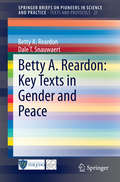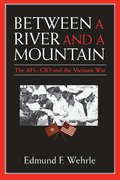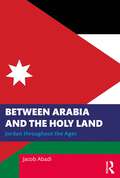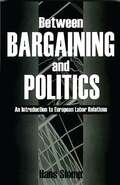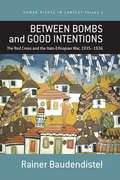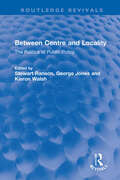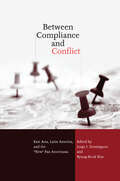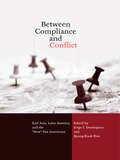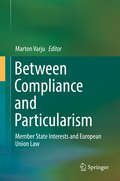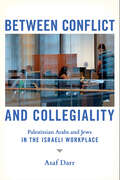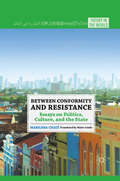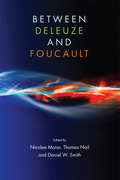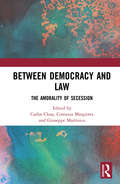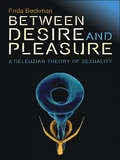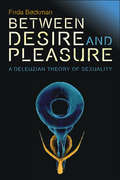- Table View
- List View
Betty A. Reardon: Key Texts in Gender and Peace (SpringerBriefs on Pioneers in Science and Practice #27)
by Betty A. Reardon Dale T. SnauwaertThis book presents a rich collection of Betty A. Reardon’s writing on gender studies, sexism and the war system, and human security from a feminist perspective. Betty A. Reardon is a pioneer of gender studies who, as a feminist, identified the structural relationship between sexism and the war system and, as a scholar, a shift from national to human security. As a pioneer in contemporary theories on gender and peace, Betty A. Reardon has continually developed research on the integral relationship between patriarchy and war, and has been an outspoken advocate of gender issues as an essential aspect of peace studies, of problems of gender equity as the subject of peace research, and of gender experience as a crucial factor in defining and attaining human security. Her work evolved in the context of international women’s movements for human rights, peace and the United Nations, and is widely drawn upon by activists and educators in order to introduce a gender perspective to peace studies and education and a peace perspective to women’s studies.
Between a River and a Mountain: The AFL-CIO and the Vietnam War
by Edmund F. WehrleBetween a River and a Mountain details American labor's surprisingly complex relationship to the American war in Vietnam. Breaking from the simplistic story of "hard hat patriotism," Wehrle uses newly released archival material to demonstrate the AFL-CIO's continuing dedication to social, political, and economic reform in Vietnam. The complex, sometimes turbulent, relationship between American union leaders and their counterparts in the Vietnamese Confederation of Labor (known as the CVT) led to dangerous political compromises: the AFL-CIO eventually accepted much-needed support for their Vietnamese activities from the CIA, while the CVT's need to sustain their relationship with the Americans lured them into entanglements with a succession of corrupt Saigon governments. Although the story's endpoint--the painfully divided and weakened labor movement of the 1970s--may be familiar, Wehrle offers an entirely new understanding of the historical forces leading up to that decline, unraveling his story with considerable sophistication and narrative skill. "Stunning in its research and sophisticated in its analysis, Between a River and a Mountain is one of the best studies we have of labor and the Vietnam War." --Robert K. Brigham, Shirley Ecker Boskey Professor of History and International Relations, Vassar College "Skillfully blending diplomatic and labor history, Wehrle's book is a valuable contribution to the ever-widening literature on the Vietnam War." --George Herring, University of Kentucky "Wehrle has written a compelling and original study of the AFL-CIO, the South Vietnamese labor movement and the Vietnam War." --Judith Stein, Professor of History, City College and Graduate School of the City University of New York "With this important book, Edmund Wehrle gives us the first full-fledged scholarly examination of organized labor's relationship to the Vietnam War. Based on deep research in U.S. and foreign archives, and presented in clear and graceful prose, Between a River and a Mountain adds a great deal to our understanding of how the AFL-CIO approached the war and in turn was fundamentally altered by its staunch support for Americanization. Nor is it merely an American story that Wehrle tells, for he also presents fascinating information on the Vietnamese Confederation of Labor and its sometimes-strained relations with U.S. labor." --Fredrik Logevall, Cornell University Edmund F. Wehrle is Assistant Professor of History, Eastern Illinois University.
Between Arabia and the Holy Land: Jordan throughout the Ages
by Jacob AbadiThis volume is a general survey of the history of Jordan from ancient times to the present.The author covers the major events that took place in this region since ancient times. Starting with the history of the region in Biblical times, the author discusses the major developments in the ancient kingdoms of Edom, Moab, and Amon, which shared common borders with the Hebrew kingdoms. He then provides a detailed coverage of the events that took place during the Nabatean period.The author demonstrates how the character of this region had changed with the rise of Islam and the expansion of the Arabs and their encounter with the Byzantines. In addition, the author demonstrates how the rise of the Mamluk Sultanate affected the region. The author provides a detailed analysis explaining how the Hashemite Kingdom Jordan emerged and how the Ottomans and the British contributed to its rise. In addition to the political developments that took place in this region, the reader will become familiar with the economic, social, and cultural developments which contributed to the emergence of the modern Hashemite Kingdom. The book’s audience includes college undergraduates, graduates, postgraduates, scholars, as well as lay readers with interest in this strategically important region.The book is based on primary and secondary sources written in several languages.
Between Arabia and the Holy Land: Jordan throughout the Ages
by Jacob AbadiThis volume is a general survey of the history of Jordan from ancient times to the present.The author covers the major events that took place in this region since ancient times. Starting with the history of the region in Biblical times, the author discusses the major developments in the ancient kingdoms of Edom, Moab, and Amon, which shared common borders with the Hebrew kingdoms. He then provides a detailed coverage of the events that took place during the Nabatean period.The author demonstrates how the character of this region had changed with the rise of Islam and the expansion of the Arabs and their encounter with the Byzantines. In addition, the author demonstrates how the rise of the Mamluk Sultanate affected the region. The author provides a detailed analysis explaining how the Hashemite Kingdom Jordan emerged and how the Ottomans and the British contributed to its rise. In addition to the political developments that took place in this region, the reader will become familiar with the economic, social, and cultural developments which contributed to the emergence of the modern Hashemite Kingdom. The book’s audience includes college undergraduates, graduates, postgraduates, scholars, as well as lay readers with interest in this strategically important region.The book is based on primary and secondary sources written in several languages.
Between Bargaining and Politics: An Introduction to European Labor Relations
by Hans SlompThis text provides an overview and concise introduction to labor relations in Europe. The author seeks to transcend nationalism in labor relations by focusing his discussion and analysis on the continent as a whole and on groups of countries. The national focus is to some extent given up, not for a concentration on differences within nations, but in favor of a discussion of common European developments. European labor relations have a number of basic features in common, not only in collective bargaining and conflict, but also in worker participation and in the role of national governments. And, in a number of ways, these features are strikingly different from the labor relations model seen in the United States. The text, therefore, offers an illuminating analysis of commonalities and differences within European labor relations, as well as between the United States and Europe.
Between Bombs and Good Intentions: The International Committee of the Red Cross (ICRC) and the Italo-Ethiopian war, 1935-1936 (Human Rights in Context #1)
by Rainer BaudendistelThe wars in Afghanistan and Iraq have highlighted again the precarious situation aid agencies find themselves in, caught as they are between the firing lines of the hostile parties, as they are trying to alleviate the plight of the civilian populations. This book offers an illuminating case study from a previous conflict, the Italo-Ethiopian war of 1935-36, and of the humanitarian operation of the Red Cross during this period. Based on fresh material from Red Cross and Italian military archives, the author examines highly controversial subjects such as the Italian bombings of Red Cross field hospitals, the treatment of Prisoners of War by the two belligerents; and the effects of Fascist Italy’s massive use of poison gas against the Ethiopians. He shows how Mussolini and his ruthless regime, throughout the seven-month war, manipulated the International Committee of the Red Cross (ICRC) – the lead organization of the Red Cross in times of war, helped by the surprising political naïveté of its board. During this war the ICRC redefined its role in a debate, which is fascinating not least because of its relevance to current events, about the nature of humanitarian action. The organization decided to concern itself exclusively with matters falling under the Geneva Conventions and to give priority to bringing relief over expressing protest. It was a decision that should have far-reaching consequences, particularly for the period of World War II and the fate of Jews in Nazi concentration camps.
Between Centre and Locality: The Politics of Public Policy (Routledge Revivals)
by Stewart Ranson George Jones Kieron WalshFirst published in 1985, Between Centre and Locality provides the detailed accounts of the relations between central and local government in Britain since 1970s. The confrontation of centre and locality has been a constant theme of political debate and legislative action since Mrs Thatcher came to power. It discusses range of policy issues including education, the police, housing, race relations and finance. In addition, theoretical chapters are included which set the empirical studies in the broader context of theories of the State and of policy making. The chapters have each been written by an acknowledged authority on the particular subject and are based upon extensive research. The book will be of interest not only to academics in a number of fields but also to politicians, officers, and civil servants in central and local government.
Between Centre and Locality: The Politics of Public Policy (Routledge Revivals)
by Stewart Ranson George Jones Kieron WalshFirst published in 1985, Between Centre and Locality provides the detailed accounts of the relations between central and local government in Britain since 1970s. The confrontation of centre and locality has been a constant theme of political debate and legislative action since Mrs Thatcher came to power. It discusses range of policy issues including education, the police, housing, race relations and finance. In addition, theoretical chapters are included which set the empirical studies in the broader context of theories of the State and of policy making. The chapters have each been written by an acknowledged authority on the particular subject and are based upon extensive research. The book will be of interest not only to academics in a number of fields but also to politicians, officers, and civil servants in central and local government.
Between Compliance and Conflict: East Asia, Latin America and the "New" Pax Americana
by Jorge I. Domínguez Byung-Kook KimThis book examines the responses to U.S. power in the two areas of the world where U.S. primacy was first successfully consolidated: East Asia and Latin America. The U.S. has faced no comparably powerful challengers to the exercise of its power in Latin America for much of the past century. It established its primacy over much of East Asia in the aftermath of WW II and extended its influence in the late 1970's and after the end of the Vietnam War through its entente with China to balance the Soviet Union. By contrast, the U.S. has always encountered rivals and challengers in Europe, has attempted unsuccessfully thus far to impose its primacy in the Middle East, and has paid only intermittent attention to South Asia and Africa. The essays in this volume will explore three important themes 1.) How do region-wide economic trends and arrangements sustain or modify U.S. influence in the region? 2.) How do rising powers in these regions (Japan, China, Brazil) reshape their policies to cope with the U.S. and 3.) How do new (South Korea) and old (Cuba) challengers to U.S. power shape their policies to account for the unrivaled exercise of U.S. power. This collection will place the United States at the hub of relations with countries in East Asia and Latin America and examine the new policies and new styles of engagement that are employed to address the prolonged U.S. interest in these areas-approaches from which the rest of the world might learn.
Between Compliance and Conflict: East Asia, Latin America and the "New" Pax Americana
by Jorge Dominguez Byung-Kook KimThis book examines the responses to U.S. power in the two areas of the world where U.S. primacy was first successfully consolidated: East Asia and Latin America. The U.S. has faced no comparably powerful challengers to the exercise of its power in Latin America for much of the past century. It established its primacy over much of East Asia in the aftermath of WW II and extended its influence in the late 1970's and after the end of the Vietnam War through its entente with China to balance the Soviet Union. By contrast, the U.S. has always encountered rivals and challengers in Europe, has attempted unsuccessfully thus far to impose its primacy in the Middle East, and has paid only intermittent attention to South Asia and Africa. The essays in this volume will explore three important themes 1.) How do region-wide economic trends and arrangements sustain or modify U.S. influence in the region? 2.) How do rising powers in these regions (Japan, China, Brazil) reshape their policies to cope with the U.S. and 3.) How do new (South Korea) and old (Cuba) challengers to U.S. power shape their policies to account for the unrivaled exercise of U.S. power. This collection will place the United States at the hub of relations with countries in East Asia and Latin America and examine the new policies and new styles of engagement that are employed to address the prolonged U.S. interest in these areas-approaches from which the rest of the world might learn.
Between Compliance and Particularism: Member State Interests and European Union Law
by Marton VarjuThe book examines how the interests of the member states, which provide the primary driving force for developments in European integration, are internalised and addressed by the law of the European Union. In this context, member state interests are taken to mean the policy considerations, economic calculations, local socio-cultural factors, and the raw expressions of political will which shape EU policies and determine member state responses to the obligations arising from those policies. The book primarily explores the junctions and disjunctions between member state interests defined in such a manner and EU law, where the latter expresses either an obligation for the member states to comply with common policies or an acceptance of member state particularism under the common EU framework.
Between Conflict and Collegiality: Palestinian Arabs and Jews in the Israeli Workplace
by Asaf DarrBetween Conflict and Collegiality explores how ethnonational-religious struggle between Jews and Palestinians affects relations in ethnically mixed work teams in Israel. Asaf Darr documents the tensions that permeate the workplace and reveals when such tensions threaten the cohesion of the work environment. Darr chronicles the grassroots coping strategies employed by both Jewish and Palestinian through field studies conducted with workers in various sectors in Israel, adopting a comparative method that identifies the differences in how ethnonational-religious tensions play out. Between Conflict and Collegiality asks how workers deal with external ethnonational and religious pressures and whether the broader ethnonational conflict is reflected in the career expectations and trajectories of minority group members. Darr examines whether minority group members' use of their own language at work become a point of contestation; how religion is manifested in the workplace; whether co-workers from different ethnonational groups form amicable relations that extend beyond the workplace; and whether positive experiences working in ethnically mixed workplaces have the potential to mitigate conflict in the wider society.
Between Conformity and Resistance: Essays on Politics, Culture, and the State (Theory in the World)
by M. ChauíSince the 1980's, Marilena Chauí's writing has had a profound impact in Brazil, contributing to the academic conversation and resonating in popular culture. Here, in English for the first time, are ten of Chauí's most important essays, with an introduction by Maite Conde which situates the scholarship in the global context.
Between Cosmopolitan Ideals and State Sovereignty: Studies in Global Justice
by R. Tinnevelt G. VerschraegenBetween Cosmopolitan Ideals and State Sovereignty explores how philosophers and political theorists have recast principles of justice and human rights in the light of challenges posed by globalization. It discusses ethical issues that arise at a global level and considers whether human rights and sovereignty can ever be reconciled.
Between Debt and the Devil: Money, Credit, and Fixing Global Finance
by Adair TurnerAdair Turner became chairman of Britain's Financial Services Authority just as the global financial crisis struck in 2008, and he played a leading role in redesigning global financial regulation. In this eye-opening book, he sets the record straight about what really caused the crisis. It didn’t happen because banks are too big to fail—our addiction to private debt is to blame.Between Debt and the Devil challenges the belief that we need credit growth to fuel economic growth, and that rising debt is okay as long as inflation remains low. In fact, most credit is not needed for economic growth—but it drives real estate booms and busts and leads to financial crisis and depression. Turner explains why public policy needs to manage the growth and allocation of credit creation, and why debt needs to be taxed as a form of economic pollution. Banks need far more capital, real estate lending must be restricted, and we need to tackle inequality and mitigate the relentless rise of real estate prices. Turner also debunks the big myth about fiat money—the erroneous notion that printing money will lead to harmful inflation. To escape the mess created by past policy errors, we sometimes need to monetize government debt and finance fiscal deficits with central-bank money.Between Debt and the Devil shows why we need to reject the assumptions that private credit is essential to growth and fiat money is inevitably dangerous. Each has its advantages, and each creates risks that public policy must consciously balance.
Between Debt and the Devil: Money, Credit, and Fixing Global Finance (PDF)
by Adair TurnerAdair Turner became chairman of Britain's Financial Services Authority just as the global financial crisis struck in 2008, and he played a leading role in redesigning global financial regulation. In this eye-opening book, he sets the record straight about what really caused the crisis. It didn’t happen because banks are too big to fail—our addiction to private debt is to blame.Between Debt and the Devil challenges the belief that we need credit growth to fuel economic growth, and that rising debt is okay as long as inflation remains low. In fact, most credit is not needed for economic growth—but it drives real estate booms and busts and leads to financial crisis and depression. Turner explains why public policy needs to manage the growth and allocation of credit creation, and why debt needs to be taxed as a form of economic pollution. Banks need far more capital, real estate lending must be restricted, and we need to tackle inequality and mitigate the relentless rise of real estate prices. Turner also debunks the big myth about fiat money—the erroneous notion that printing money will lead to harmful inflation. To escape the mess created by past policy errors, we sometimes need to monetize government debt and finance fiscal deficits with central-bank money.Between Debt and the Devil shows why we need to reject the assumptions that private credit is essential to growth and fiat money is inevitably dangerous. Each has its advantages, and each creates risks that public policy must consciously balance.
Between Deleuze and Foucault
by Nicolae Morar Thomas NailDeleuze and Foucault had a long, complicated and productive relationship, in which each was at various times a significant influence on the other. This collection combines 3 original essays by Deleuze and Foucault, in which they respond to each other’s work, with 16 critical essays by key contemporary scholars working in the field. The result is a sustained discussion and analysis of the various dimensions of this fascinating relationship, which clarifies the implications of their philosophical encounter.
Between Deleuze and Foucault (Edinburgh University Press)
by Nicolae Morar Thomas NailDeleuze and Foucault had a long, complicated and productive relationship, in which each was at various times a significant influence on the other. This collection combines 3 original essays by Deleuze and Foucault, in which they respond to each other’s work, with 16 critical essays by key contemporary scholars working in the field. The result is a sustained discussion and analysis of the various dimensions of this fascinating relationship, which clarifies the implications of their philosophical encounter.
Between Democracy and Law: The Amorality of Secession
by Carlos Closa Costanza Margiotta Giuseppe MartinicoThis volume purports to explore the legal and political issues triggered by the new wave of secessionism. More specifically, those issues concern the interplay between notions of democracy (and democratic ends and means) and law (and the rule of law and constitutionalism). Against this background, the editors use amorality in order to escape the terrain of the justification of secession by making a distinction between the democratic theory of secession and the theory of democratic secession. In the first section, the theoretical nexus democracy-secession has been approached both from a legal and political theory perspective. The second section of the book examines the instruments that the theory of democratic secession invokes in order to justify secession and presents both legal and political science contributions. The third section focuses on social movements and political actors. The fourth section focuses on two case studies due to the awareness of the importance of the difference between secession in a democratic occidental context (which call into play the discussion of the democratic theories) and separations in a non-democratic context (where the nexus between secession and democracy is not really central).
Between Democracy and Law: The Amorality of Secession
by Giuseppe Martinico Costanza Margiotta Carlos ClosaThis volume purports to explore the legal and political issues triggered by the new wave of secessionism. More specifically, those issues concern the interplay between notions of democracy (and democratic ends and means) and law (and the rule of law and constitutionalism). Against this background, the editors use amorality in order to escape the terrain of the justification of secession by making a distinction between the democratic theory of secession and the theory of democratic secession. In the first section, the theoretical nexus democracy-secession has been approached both from a legal and political theory perspective. The second section of the book examines the instruments that the theory of democratic secession invokes in order to justify secession and presents both legal and political science contributions. The third section focuses on social movements and political actors. The fourth section focuses on two case studies due to the awareness of the importance of the difference between secession in a democratic occidental context (which call into play the discussion of the democratic theories) and separations in a non-democratic context (where the nexus between secession and democracy is not really central).
Between Desire and Pleasure: A Deleuzian Theory of Sexuality (Plateaus - New Directions in Deleuze Studies)
by Frida BeckmanIntervening into fields including posthumanist, disability, animal and feminist studies, and current critiques of capitalism and consumerism, Frida Beckman recovers a theory of sexuality from Deleuze's work.
Between Desire and Pleasure: A Deleuzian Theory of Sexuality (Plateaus - New Directions in Deleuze Studies)
by Frida BeckmanIntervening into fields including posthumanist, disability, animal and feminist studies, and current critiques of capitalism and consumerism, Frida Beckman recovers a theory of sexuality from Deleuze's work.
Between Development and Destruction: An Enquiry into the Causes of Conflict in Post-Colonial States
by Kumar Rupesinghe Paul Sciarone Luc Van De GoorMuch has already been written about the effects of the changes of the Cold War on conflict. The ongoing disengagement of East and West from bipolar Cold-War politics has resulted in an unstable international political situation which is characterized by regional conflicts. Most analyses now concentrate on the consequences for Europe and the former communist Central and East European states. This book, however, explores the effects for the Third World. The contributors provide major theoretical analyses of the causes of conflict in developing countries. Four main factors are distinguished: the processes of state-formation and nation-building; the rise or return of ethnicity and nationalism; socio-economic factors; and the armaments-conflict nexus. The volume also provides in-depth regional analyses, as well as policy perspectives on the issue of conflict and development.
Between Diplomacy and Non-Diplomacy: Foreign relations of Kurdistan-Iraq and Palestine
by Gülistan Gürbey Sabine Hofmann Ferhad Ibrahim SeyderThis book compares the involvement of Kurdistan-Iraq and Palestine (Palestinian Territory of the West Bank and Gaza Strip) in international relations from the viewpoint of their practical performance. In particular, it provides an overview over the current Kurdish and Palestinian paradiplomatic activities and their practical performance in terms of their capabilities, capacities and practical achievements. The contributing authors analyze the evolution of paradiplomacy, the domestic legal and institutional framework, the goals, instruments, and capabilities of Kurdish and Palestinian paradiplomacy, and selected foreign relations. The book identifies the similarities and differences between the paradiplomacy of Kurdistan-Iraq and Palestine with regard to a set of guidelines: causes, legal foundations, institutionalization, predominant motives, practical implementation, and outcomes of paradiplomacy. It provides empirical explanations about how and why Kurdistan-Iraq and Palestine develop and practice paradiplomacy and contributes to a better understanding of Kurdistan-Iraq’s and Palestine’s involvement in international affairs and their activities.
Between Discipline and a Hard Place: The Value of Contemporary Art
by Alana JelinekWritten from the perspective of a practising artist, this book proposes that, against a groundswell of historians, museums and commentators claiming to speak on behalf of art, it is artists alone who may define what art really is.Jelinek contends that while there are objects called 'art' in museums from deep into human history and from around the globe - from Hans Sloane's collection, which became the foundation of the British Museum, to Alfred Barr's inclusion of 'primitive art' within the walls of MoMA, the Museum of Modern Art - only those that have been made with the knowledge and discipline of art should rightly be termed as such. Policing the definition of art in this way is not to entrench it as an elitist occupation, but in order to focus on its liberal democratic potential.The Discipline of Art describes the value of art outside the current preoccupation with economic considerations yet without resorting to a range of stereotypical and ultimately instrumentalist political or social goods, such as social inclusion or education. A wider argument is also made for disciplinarity, as Jelinek discusses the great potential as well as the pitfalls of interdisciplinary and multidisciplinary working, particularly with the so-called 'creative' arts.A passionate treatise arguing for a new way of understanding art that forefronts the role of the artist and the importance of inclusion within both the concept of art and the art world.
